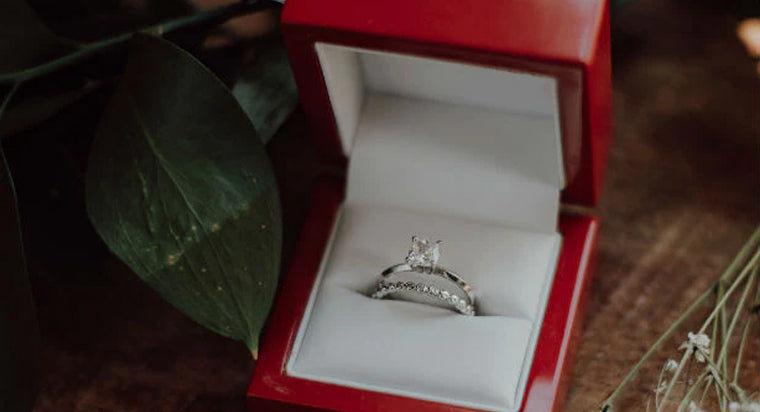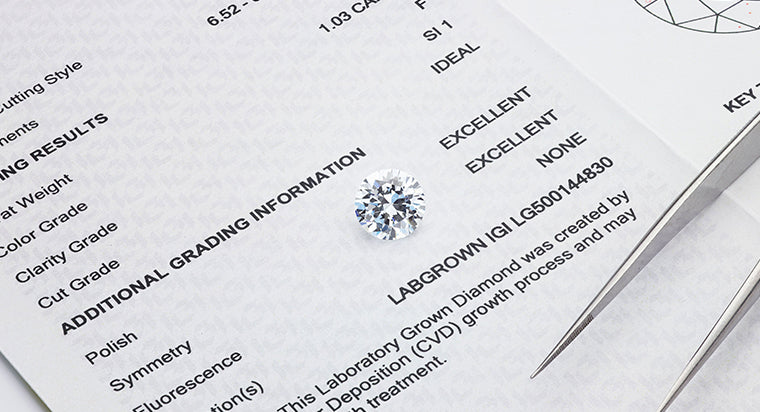What Are Diamonds Made Of? And Are Synthetic Diamonds Real?

Diamonds are a highly valued stone, nearly revered in modern society as a symbol of love, commitment, and wealth. But what elements are diamonds made of? And how are they made?
Similar to graphite, diamonds are comprised purely of carbon. The carbon atoms in diamonds are organized as a rigid lattice, allowing less possibility of contamination and awarding it the title of the hardest known natural material.
TABLE OF CONTENTS
Origin of Diamond Colors
While colorless diamonds are often considered the most valuable, diamonds exist in a wide range of colors due to mineral contamination or lattice deformation. For example, black diamonds come from graphite contamination, red diamonds from plastic deformation, purple from plastic deformation and hydrogen contamination, green from irradiation deformation, pink from plastic deformation, and brown, yellow, orange, and blue from nitrogen.
But when asking yourself what are diamonds made out of, carbon isn't the only ingredient. Diamonds have three other crucial ingredients: pressure, heat, and time.
Diamond Heat, Pressure, & Time
Diamonds are formed in the Earth's mantle, somewhere between 1 and 3 billion years ago. Formed by heat and pressure, diamonds are then delivered to the Earth's surface by deep-source volcanic eruptions or the movement of subduction zones that bring the diamonds up to the ocean floor. In addition to being formed deep in the Earth, diamonds can also be formed from the immense heat and pressure of asteroid strikes.
Diamonds require environments of at least 752 degrees Fahrenheit (400 degrees Celsius) and 434,113 pounds per square inch (30 kilobars). The most favorable diamond-forming conditions can be found about 100 miles (160 kilometers) underground.
Origin of Lab or Synthetic Diamonds
Due to the high cost of natural diamonds, geologists have developed methods to create lab stones and synthetic stones. According to the American Museum of Natural History, Swedish and American researchers in the 1950s were the first to discover how to convert graphite and molten iron into a diamond.
What are lab/lab created/man made diamonds?
Although produced in a laboratory setting, man made diamonds are formed by a process similar to that of naturally formed diamonds, utilizing the application of intense heat and pressure to pure carbon. To the naked eye, lab grown diamonds are visually indistinguishable from natural diamonds but are often 15% to 30% lower in price. When purchasing a naturally formed diamond, it is crucial to purchase a certified diamond because it is extremely difficult to differentiate real and lab diamonds.
How are lab diamonds created?
Generally lab diamonds are grown using natural or lab diamond seed(s). With a diamond seed scientists are able to replicate its physical, visual, and chemical properties. There are two types of main methods used:
How long does it take to make a lab diamond?
While mined diamonds can take 1 million to 3 million years to form, lab diamonds need as little as 2 to 6 weeks to grow. All thanks to advanced technology, lab diamonds can be grown and enter the market much faster than their natural counterparts.
Synthetic Diamonds Use in Modern Society
Although diamonds are exalted in modern society as a symbol of love and wealth, the world's hardest natural substance is also popular outside of the fashion world. According to the Natural Museum of History, diamonds conduct heat five times faster than copper, can pass or block electrical currents, and can endure extreme temperatures and chemical exposure. Sharpened diamonds are often used as specialized drill bits used in producing microchips and semiconductors. Since natural diamonds are rarer, lab grown diamonds are used more for industrial purposes. Whereas simulated diamonds are great for meeting demands for aesthetic purposes, regardless of their origin.
What are synthetic diamonds?
Synthetic diamonds can be another name for lab created diamonds. However, when it comes to labeling lab diamonds as synthetic because it is fake, that is incorrect. In regards to "fake diamonds", simulated diamonds is a better way to differentiate.
What are simulated diamonds?
These are stones made to look like diamonds. Some examples of diamond simulants are zirconia, moissanite, and rhinestones. From a gemologist perspective, simulated diamonds do not have the same beauty, versatility, or longevity as lab grown and naturally grown diamonds.
Why one would purchase a lab diamond?
Guarantee of Ethical Origin: In addition to being used in technology, lab diamonds are sometimes preferred by jewelry seekers because of their ethical origins. Natural diamonds are veiled in a dark history of fueling wars and bloodshed while diamond mining poses a threat to the environment, leaving the earth riddled with giant diamond mining holes. In order to avoid the often unethical origins of natural diamonds, many shoppers intentionally search for man made diamonds. That being said, With Clarity commits to conflict-free diamonds, natural or lab.
More budget-friendly: In comparison to natural diamonds, for lab diamonds you can expect to pay from 15% to 30% less. Lab grown diamonds' affordability has been making more couples choose this type of stone. Man made diamonds have a smaller price tag because mined diamonds need more costly resources and work through a more extended supply chain.
FAQs
Are lab diamonds worth anything?
Are lab diamonds real diamonds?
Can you insure a lab grown diamond?











